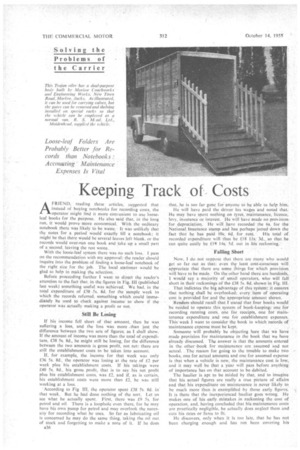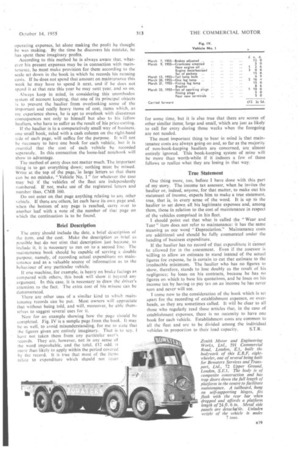Keeping Track of Costs
Page 70

Page 73

If you've noticed an error in this article please click here to report it so we can fix it.
AFRIEND, reading .these articles, suggested that instead of buying notebooks for recording costs, the operator .Might find it more convenient to. use looseleaf books for the purpose. He also said that, in the long run, it would prove more economical. With the ordinary. notebook .there was likely to be waste. • It was unlikely that the notes for a period would exactly fill a notebook; it might be that there would he several leaves left blank, or the records would over-run one book and take up a small part of a.second. leaving the rest waste.
With the loose-leaf system there was no such loss. I pass on the recommendation with my approval: the reader should inquire into the problem of finding a loose-leaf notebook of the right size for the job. The local, stationer would he glad to help in making the selection.
Before proceeding further I wante to direct the reader's attention to the fact that, in the figures in Fig. III (published last week) something useful was achieved. We had, in the total expenditure of £38 .5s. 8d. for the sample week to which the records referred, something which could immediately be used to check against income to show if the operator was actually making a profit or not.
Still Be Losing
If his income fell short of that amount, then he was suffering a loss, and the loss was more .than just the difference between the two sets of figures, as I shall show. If the amount of income was more than the total of expenditure, £38 5s. 8d., he might still be losing, for the difference between the two amounts is gross profit, not net: there are still the establishment costs to be taken into account.
If, for example, the income for that week was only £36 5s. &I., the operator was losing at the rate of £2 per week plus his establishment costs. If his takings were £40 5s. 8d., his gross profit, that is to say. his net profit plus his establishment costs, was £2. and if, as is certain, his establishment costs were more than £2, he was still working at a loss.
'According to Fig III, the operator spent £38 5s. 8d. in' that week. But he had done nothing of the sort. Let us see what he actually spent. First, there was £9 5s. for petrol and oil. There is a loophole even there, for he may have his own pump for petrol and may overlook the necessity for recording what he uses. So far as lubricating oil is concerned he may do the same thing, taking the oil out. of stock and forgetting to make a note of it. If he does a36 that, he is too far gone for anyone to be able to help him.
He will have paid the driver his wages and noted that. He may have spent nothing on tyres, maintenance, licence, levy, insurance or interest. He will have made no provision for depreciation... He will have recorded the 6s. for the National Insurance stamp and has perhaps jotted down the fact that he has paid 10s. 6d, for .rent. His total of recorded expenditure will thus be £18 I Is. 3d., so that he can quite easily be £19 14s... 5d. out in his reckoning.
Falling Short Now, I do not suppose that there are many who would get so far out as that: even the least cost-conscaaus will appreciate that there are some .t.hings for which provision . will have to he made.On the other hand there are hundreds, I would say a majority of small operators, who will fall short in their reckonings of the £38 5s. 8d. shown in Fig. HI.
That indicates the big advantage of this system: it ensures that nothing shall he overlooked; every item of operating cost is provided for and the appropriate amount shown.
Readers should recall that I stated that four books would be needed to operate this system of book-keeping: one for recording running costs, one for receipts, one for maintenance expenditure and one for establishment expenses. This week I want to consider the book in which records of
maintenance expense must be kept. •
Someone will probably be objecting here that we have made provision for maintenance in the book that we have already discussed. The answer is that the amounts entered in the other %book for maintenance are assumed and not actual. The reason for going to the trouble to make two books, one for actual amounts and one for assumed expense is that when a vehicle is new, the maintenance cost is low, and it may well be that a yea. r will pass before anything of importance has on that account to be debited.
The haulier is apt to be misled by that, and to imagine that his actual figures are really a true picture of affairs and that his expenditure on maintenance is never likely to he much more than is exemplified by those early figures, It is there that the inexperienced haulier goes wrong. He makes one of his early mistakes in reckoning the cost of operation, and, having concluded that his maintenance costs are practically negligible, he actually does neglect them and cuts his rates or fares to fit.
He discovers, only when it is. too late, that he has not been charging enough and has not been covering his operating expenses, let alone making the profit he thought he was making. By the time he discovers his mistake, he has spent these imaginary profits.
According to this method he is always aware that, whatever his present expenses may be in connection with maintenance, he must make provision for them according to the scale set down in the book in which he records his running costs. If he does not spend that amount on maintenance this week he may have to spend it next, and if he does not spend it at that rate this year he may next year, and so on.
Always keep in mind, in considering this unorthodox s.stem of account keeping, that one of its principal objects is to prevent the haulier from overlooking some of the important and really heavy items of cost, items which, as my experience shows, he is apt to overlook with disastrous consequences not only to himself but also to his fellow hauliers, who have to suffer as the result of his price-cutting.
If the haulier is in a comparatively small way of business, one small book, ruled with a cash column on the right-hand side of each page, will suffice for the purpose. It will not be necessary to have one book for each vehicle, but it is essential that the cost of each vehicle be recorded separately. . In this connection the loose-leaf notebook will show to advantage.
The method of entry does not matter much. The important thing is to get everything down; nothing Must be missed. Write at the top of the page, in large letters so that there can be no mistake, "Vehicle NO. 1" (or whatever the case may be if the vehicles of the fleet are independently numbered. If 'not, make use of the registered letters and number thus, CM13.160.
Do not enter On. that page anything, relating to any other ,ehicle. If there are others, let each have its own page and. when the bottom of any page is reached, carry over to another leaf with a note of the number of that page on vhhich the. continuation is to be found:
Brief Description The entry should Maude the date, a brief descripiion of the item, and the cost Make the description as brief as possible but do not stint that description just because, to include it, it is necessary to run on toa second line. The maintenance book should be capable of serving a double purpose, namely, of recording actual expenditure on Maintenance and as a valuable source of information as to the behaviour of any particular vehicle.
If one machine, for example, is heavy on brake facings as compared with others, this book will show it beyond any argument. In this case, it is necessary to draw the driver's attention to the fact The extra cost of his misuse can be demonstrated.
There are other uses of a similar kind to which maintenance records can be put. Most owners will appreciate that without being told, and will, moreover, be able themselves to suggest several uses for it.
Now for an example showing how the page should be completed. Fig. IV is a sample page from the book. It may he as well, to avoid misunderstanding, for me to state that the figures given arc entirely imaginary. That is to say. I have not taken them from any particular user's records. They arc, however, not in any sense of the word improbable, and the total. £12 odd, is more than likely to apply within the period covered hy the record. It is true that most of the items relate to expenditure which should not recur for some time, but it is also true that there are scores of other similar items, large and small, which are just as likely to call for entry during those weeks when the foregoing are not needed.
The most important thing to bear in mind is that maintenance costs are always going on and, so far as the majority of non-book-keeping hauliers are concerned, are almost entirely ignored. This book-keeping system of mine will be more than worth-while if it induces a few of those fellows to realize what they are losing in that way.
True Statement One thing more, too, before I have done with this part of my story. The income tax assessor, when he invites the haulier or, indeed, anyone, for that matter, to make out his statement of income, expects him to make a true statement, true, that is, in every sense of the word, It is up to the haulier to set down all, his legitimate expenses and, among them, those in relation to the cost of maintenance in respect of the vehicles comprised in his fleet.
I should point out that what is called the "Wear and Tear" item does not refer to maintenance: it has the same meaning as our word "Depreciation." Maintenance costs are additional and should be fully enumerated under the heading of business expenditure.
If the haulier has no record of that expenditure it cannot be allowed for in the assessment. Even if the assessor is willing to allow an estimate to stand instead of the actual figures for expense, he is certain to cut that estimate to the irreducible minimum. The haulier who has no figures to show, therefore, stands to lose doubly as the result of his negligence; he loses on his contracts, because he has no figures on which to base his quotations, and he loses on his income tax by having to pay tax on an income he has never seen and never will see.
I come now to the consideration of the book which is set apart for the recording of establishment expenses, or overheads, as they are sometimes called. It will be clear to all those who regularly read these articles that, in the case of establishment expenses, there is no necessity to have one book for each Vehicle. Establishment costs are common to all the fleet and are to be divided among the individual vehicles in proportion to their load capacity. S.T.R.




















































































































